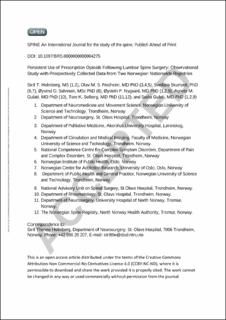| dc.description.abstract | Study Design. Prospective pharmacoepidemiological study Objective. To investigate the use of prescription opioids two years following degenerative lumbar spine surgery. Summary of Background Data. There are limited data providing details to evaluate patterns of opioid use. The number of patients is often limited and data on opioid use followign some of the most common surgical procedures are lacking. Methods. Data from the Norwegian Registry for Spine Surgery and the Norwegian Prescription Database were linked on an individual level. The primary outcome measure was persistent opioid use the second year after surgery. Functional disability was measured with the Oswestry disability index (ODI). Study participants were operated between 2007 and 2017. Results. Among 32886 study participants, 2754 (8.4%) met criteria for persistent opioid use the second year after surgery. Among persistent opioid users in the second year after surgery, 64% met the criteria for persistent opioid use the year preceding surgery. Persistent opioid use the year preceding surgery (OR 31.10, 95% CI 26.9-36.0, P = .001), use of high doses of benzodiazepines (OR 1.62, 95% CI 1.30-2.04, P = .001), and use of high doses of z-hypnotics (OR 1.90, 95% CI 1.58-2.22, P = .001) the year before surgery were associated with increased risk of persistent opioid use the second year after surgery. A higher ODI score at one year was observed in persistent opioid users compared to non-persistent users (41.5 vs 18.8 points) and there was a significant difference in ODI change (-13.7 points). Patients with persistent opioid use in the year preceding surgery were less likely to achieve a minimal clinically important ODI change at one year compared to non-persistent users (37.7% vs 52.6%, P = .001). Conclusion. Patients with or at risk of developing persistent opioid should be identified and provided counseling and support to taper off opioid treatment. | |
